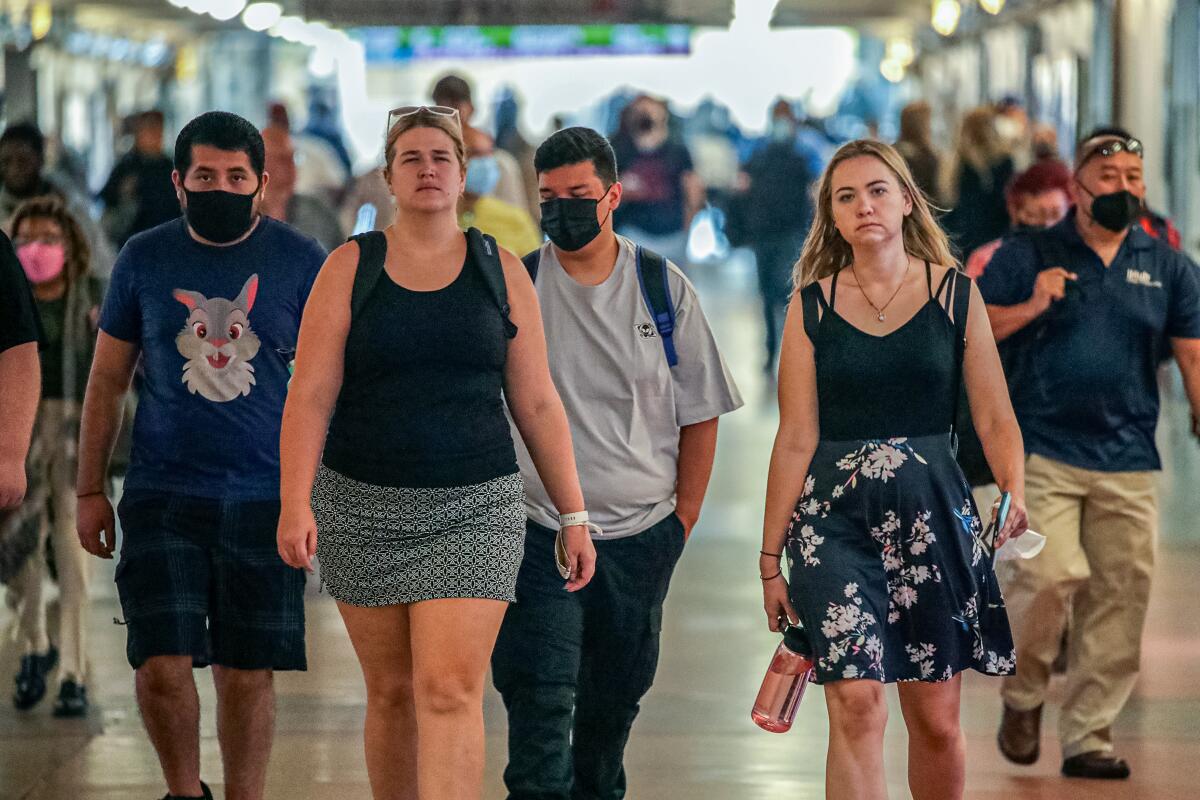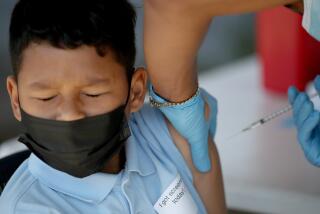L.A. County coronavirus deaths rising fast as ultra-contagious BA.5 fuels infection wave

- Share via
The number of weekly COVID-19 deaths reported in Los Angeles County has doubled over the last month — the first significant increase in fatalities since the winter surge.
Over the last week, the nation’s most populous county tallied roughly 100 COVID-19 deaths, the highest total in three months. A month ago, the county was reporting about 50 deaths a week.
Although the numbers are still a fraction of the peak in the winter, when there were more than 500 COVID-19 deaths a week, they underscore the growing concerns over new super-contagious subvariants that have fueled a new wave of infections.
“There’s a lot of misinformation circulating about COVID right now, including that, at this point, it only causes mild illness,” said L.A. County Public Health Director Barbara Ferrer. “Unfortunately, this isn’t true.”
For all the observations that Omicron is less likely to cause severe illness than the Delta variant, which was the culprit behind last summer’s surge, the coronavirus just this year has already led to three times as many deaths as the county typically recorded in an average pre-pandemic flu season.
So far in 2022, the deaths of 4,390 county residents from COVID-19 have been reported — essentially equal to the typical combined toll of the flu, drug overdoses and motor vehicle accidents over an entire calendar year, Ferrer said.
About 1,500 people in L.A. County died annually from the flu before the pandemic, one person a year from a cold, more than 2,000 a year from accidental drug overdoses and nearly 900 a year from motor vehicle accidents.
In California, an average of 37 COVID-19 deaths have been reported per day over the last week, a rate that’s remained relatively steady in the last two months. The state’s cumulative pandemic death toll has now surpassed 92,000, according to data compiled by The Times. That’s roughly equivalent to the population of Santa Monica.
L.A. County recorded nearly 12,000 COVID-associated deaths in 2020 and almost 14,500 in 2021.
The subvariant BA.5 made up 65% of U.S. coronavirus cases over the week ending Saturday. A month ago, it made up 17% of cases.
Hospitalizations are also on the rise.
The number of coronavirus-positive patients in L.A. County hospitals on any given day has doubled in the last month to nearly 1,200 as of Monday, the highest figure since February. Of them, 115 were in the intensive care unit, an increase of 64% in the last month.
Statewide, the latest census was 4,227, the highest single-day total since late February.
Only about 42% of L.A. County’s hospitalized coronavirus-positive patients are admitted specifically for COVID-19 illness — as opposed to incidentally testing positive while being in the hospital for other reasons. But officials have also noted a recent increase in the share of coronavirus-related visits to emergency departments. Two months ago, 5% of emergency room visits were coronavirus-related; now it’s close to 10%.
Emergency rooms and urgent care centers “are filled with many folks that are looking for care for their COVID-related illness,” Ferrer told the county Board of Supervisors on Tuesday.
Hospitals can still be strained even when many coronavirus-positive patients are not being treated for COVID-19 illness, given the extensive resources needed to isolate them.
Nationally, coronavirus-positive hospitalizations have nearly doubled over the last two months, rising to more than 30,000 as of Sunday. Dr. Anthony Fauci, President Biden’s chief medical advisor for the pandemic, said it’s possible there could be an uptick in COVID-related intensive care unit admissions nationally.
Since many infections aren’t reported to the government, as they’re done through at-home testing, there could be 300,000 to 500,000 actual infections a day, far more than the official reports of about 118,000, Fauci said. That estimated range would be one of the highest of the pandemic, eclipsed only by the initial Omicron surge that struck in the fall last year and winter.
It’s true that, for any given coronavirus case, the risk of being hospitalized, needing intensive care or dying is lower than it was many months ago. Still, Fauci said, a persistent high level of cases will eventually lead to more hospitalizations and more ICU stays.
That’s why it’s so important for people to get vaccinated and boosted when they’re eligible, said Dr. Rochelle Walensky, director of the U.S. Centers for Disease Control and Prevention.
“There’s a lot we can do to try and prevent these ICU stays,” she said.
Dr. Ashish Jha, the White House COVID-19 response coordinator, said, “Getting vaccinated now will not preclude you from getting a variant-specific vaccine later this fall or winter.”
And for those age 50 or older, “if you have not gotten a vaccine shot in the year 2022 ... please go get another vaccine shot,” Jha said during a briefing Tuesday. Whether you’re eligible for a first booster or second, “go get one now. It could save your life.”
Not all jurisdictions are seeing an increase in deaths. Federal data show deaths have remained relatively stable but at levels officials say are still too high. Nationwide, “we are experiencing about 300 to 350 deaths a day. That is unacceptable,” Jha said.
The latest wave has been fueled by a dizzying array of Omicron subvariants that has emerged over the last several months. Of most pressing concern now is BA.5, which officials say has dramatically increased the risk that someone could get reinfected — perhaps just weeks after an earlier case.
The crush of cases has upended workforces, and experts warn they expect to see a resulting increase in long COVID cases. In L.A. County, the number of weekly coronavirus outbreaks in nursing homes in the last month has doubled.
L.A. County has averaged about 5,900 coronavirus cases a day over the last week, its highest rate since early February, and even higher than last summer’s Delta peak of about 3,500 cases a day, according to data provided by Ferrer. The winter Omicron surge was the worst of the pandemic, topping out at about 42,000 cases a day.
The latest case average is a 14% week-over-week increase, the largest since the Fourth of July weekend, when the rate seemed to have stabilized but only likely due to delayed reporting over the holiday.
“While we’re not seeing anywhere near the devastation this summer that we saw during last winter’s Omicron surge, we are seeing much higher case numbers than we saw during the peak of the Delta surge,” Ferrer said. “It’s unlikely that we are at the peak of our recent surge, given the increased circulation of new subvariants.”
The number of new daily coronavirus-positive hospital admissions is around 150, not yet past the peak of last summer’s Delta wave of 215. But it’s possible L.A. County could reach similar numbers in the weeks to come, Ferrer said.
“Although many of those hospitalized are not there because of COVID illness, the rising numbers indicate that, for some individuals, COVID remains a very dangerous virus,” Ferrer said.
COVID-19 is more likely to cause severe illness and death among poorer people — even when vaccination status is the same. Over the spring, about 35 in 100,000 wealthy unvaccinated people were hospitalized with a coronavirus infection, whereas about 400 in 100,000 poor unvaccinated people were hospitalized.
Disparities persisted even among vaccinated people by income status. About 27 in 100,000 wealthy vaccinated people were hospitalized with a coronavirus infection, compared with 38 in 100,000 poor vaccinated people.
That means that poorer L.A. County residents — who account for the engines of significant portions of the local economy, such as food production, hospitality and tourism — are again bearing the brunt of this latest wave of illness.
“Families with fewer resources are more likely to have more exposures at work, live in crowded conditions, and have one or more chronic health conditions” than wealthier people, Ferrer said. “This places those individuals at higher risk of suffering the severe effects from COVID.... Vaccination alone is not sufficient to erase the troubling inequities.”
L.A. County has a huge concentration of poverty and overcrowded housing, making the effects of a pandemic surge particularly intense in a county with more than 10 million residents. Of all of Southern California’s coastal counties, L.A. County has the worst poverty rate and lowest median household income.
Older people are still more likely to die, but some of those dying are young. On Tuesday alone, 14 new deaths were reported, including one who was in their 30s or 40s, and four who were between 50 and 64. Four deaths were among those ages 65 to 79, and five were 80 or older.
The surge in cases is so intense that L.A. County has urged work sites with three or more coronavirus cases in a two-week period to consider encouraging employees to work remotely when feasible, especially for workers at elevated risk of severe disease.
What the next weeks could bring remains unclear. California projections suggest hospitalizations will continue to rise for the next two weeks and then start to decline. If the model ends up being right, the number of predicted hospitalizations at the peak will be “nothing like prior surges that we’ve seen,” California state epidemiologist Dr. Erica Pan said in a briefing to the California Medical Assn. on Tuesday.
Although hospitals in L.A. County are not reporting being overwhelmed by COVID-19 patients, Ferrer has said that the idea of reinstating a universal mask mandate should hospitalizations continue rising is a prudent decision.
“Waiting until hospitals are overwhelmed is way too late to try to do much about slowing transmission,” Ferrer said. “The time to slow transmission is actually when you start seeing indicators that you’re having more utilization at your hospitals.”
Ferrer has said that if L.A. County moves into the CDC-defined high COVID-19 community level and remains there for two consecutive weeks, health officials will reimpose a universal mask requirement in indoor public settings for those ages 2 and older. Such an order could become effective as early as July 29.
Should that happen, L.A. would be the only California county with such an order on the books, though the state Department of Public Health continues to strongly recommend masking in indoor public settings.
The possibility of a renewed mask mandate has been met with skepticism in some corners. Would large numbers of people comply with the order and, if so, would it even make a difference?
Although the first question can’t be answered unless an order is handed down, “there is broad consensus in the scientific community that wearing a high-quality mask in indoor public spaces is an important tool to control the spread of COVID-19,” Jha said Tuesday.
And, as Ferrer noted, “You don’t get sick if you don’t get infected.”
“When transmission is high, many more people are exposed and get infected, creating more risk for everyone, but particularly for those most vulnerable,” she said. “Universal masking and widespread use of testing are effective tools for reducing viral transmission.”
More to Read
Sign up for Essential California
The most important California stories and recommendations in your inbox every morning.
You may occasionally receive promotional content from the Los Angeles Times.
















